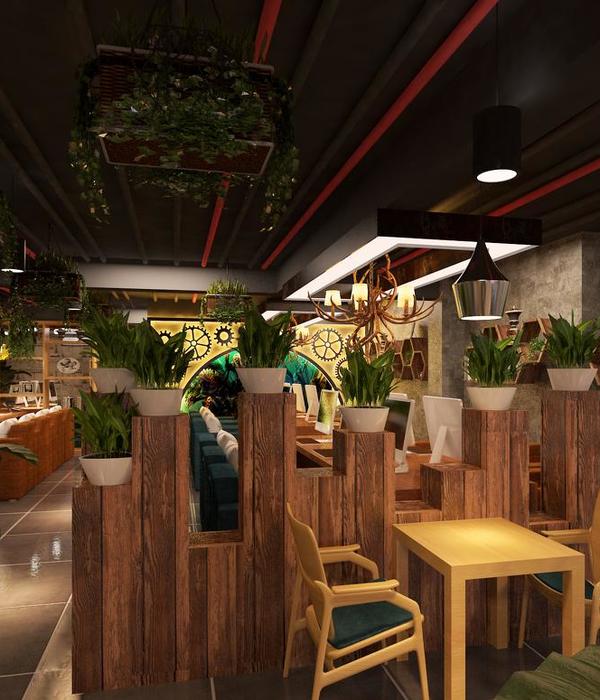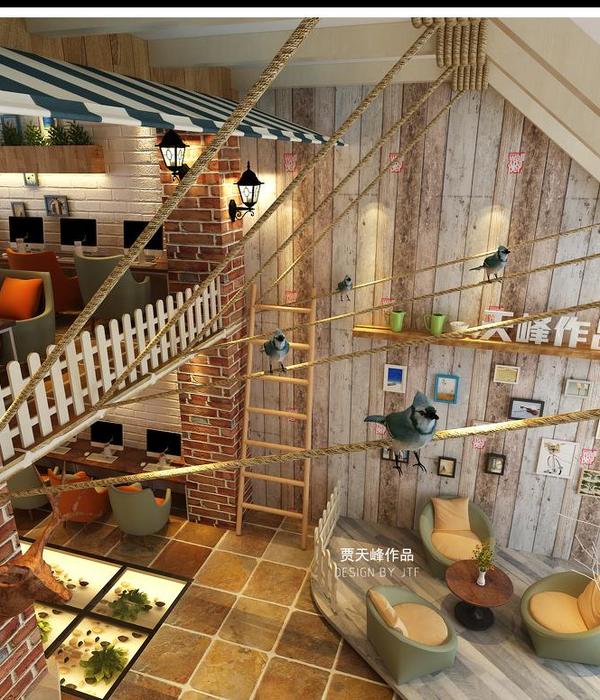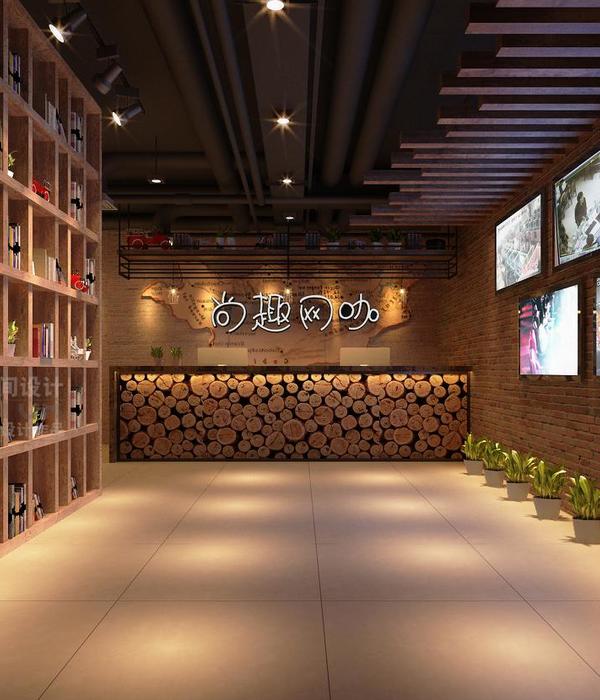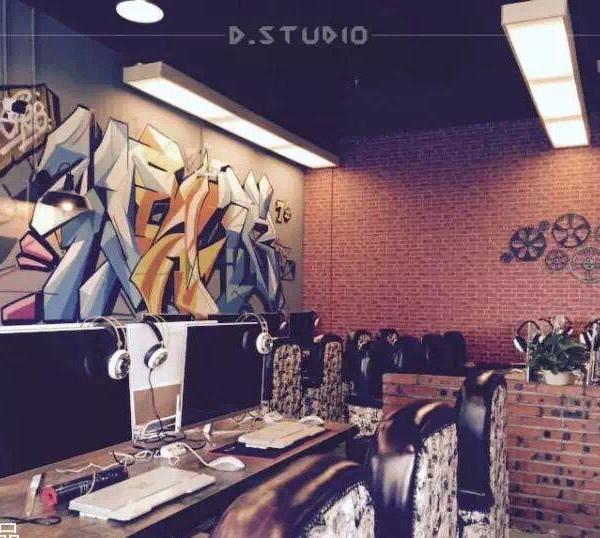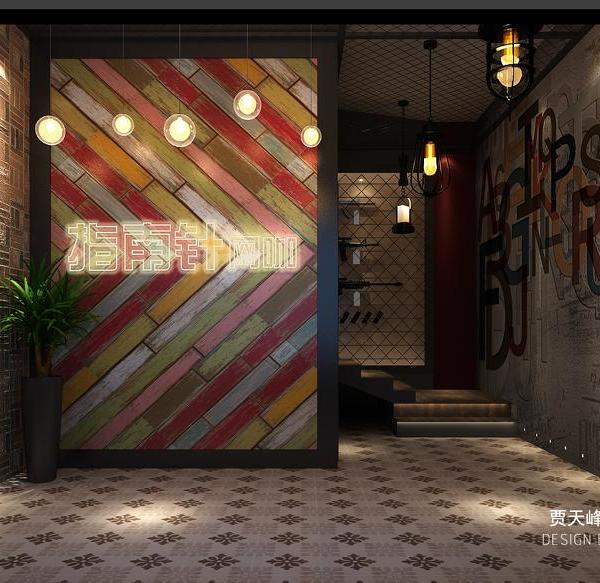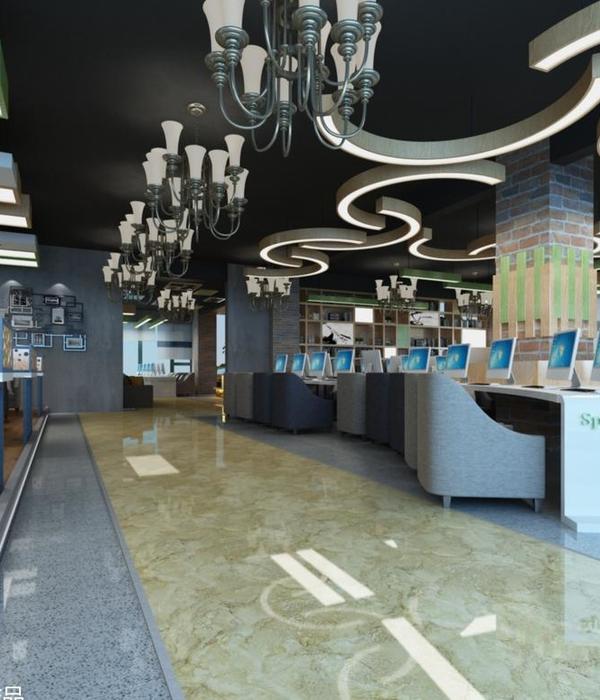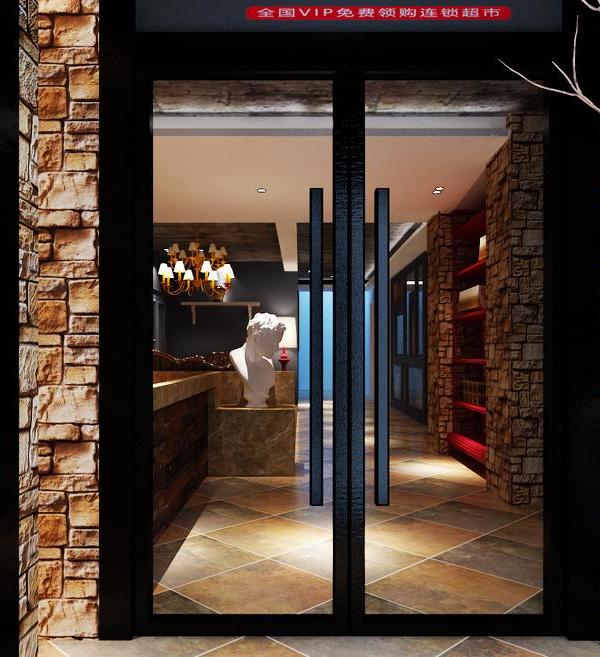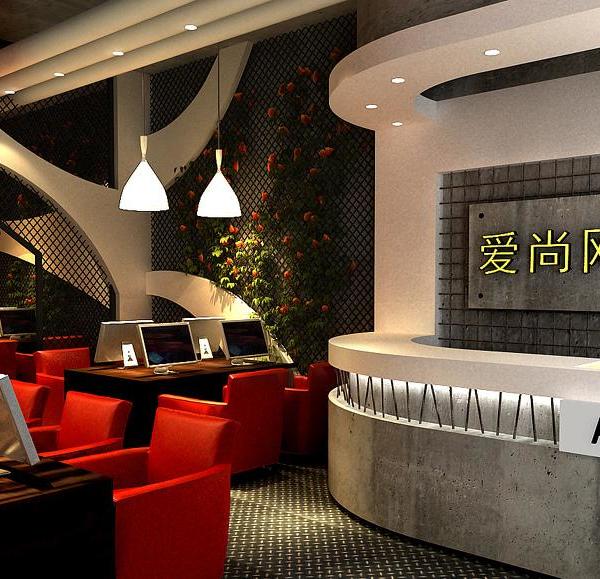与古民居共生 Coexisting with Ancient Residences
魏坡新序的项目所在地魏坡村,是坐落在千年古都洛阳北部的邙山,孟津区朝阳镇的传统文化村落。项目占地约 4.8 万平方米,场地内包含豫西地区现存最大、也是最完整的清代古民居建筑群及地坑院两个省重点文保单位,以及本次仿古商业街区改造与提升的一期工程。
The Weipo New Chapter project is located in Weipo Village, a traditional cultural village in Chaoyang Town, Mengjin District, on Mang Mountain in the northern part of Luoyang, a millennia-old capital. Covering an area of approximately 48,000 square meters, the site includes the largest and most complete group of Qing Dynasty ancient residential buildings and two sunken courtyard houses in the western Henan region, both of which are provincial cultural heritage. This project represents the first phase of the renovation and enhancement of the pseudo-classical commercial street district.
▼项目一瞥,Project overview © UK STUDIO
文旅商业的困局 The Dilemma of Cultural Tourism and Commerce
紧邻古民居,拥有天然旅游资源的古迹、文保区周围的文旅商业配套应该如何设计?蔓延全国各地的仿古商业配套街区看似是一个现成的答案,但未必是最佳选择。仿古建筑做的再好,相比旁边的“真”古建,也不可能有更大吸引力。
How should the cultural tourism and commercial facilities surrounding ancient residences and naturally endowed tourist attractions and cultural heritage sites be designed? The proliferation of pseudo-classical commercial streets nationwide might seem like an obvious answer, but it is not necessarily the best choice. No matter how well these replicas are made, they cannot surpass the allure of the genuine ancient buildings next to them.
▼改造前仿古民俗商业街,Antique folk commercial street before renovation © 华创永道
另一个误区是对消费人群的固有偏见,认为一个三线城市的建筑空间做到“三线”水平就行,不必和一线城市看齐。事实上,这一类型的仿古“风情”街的建筑空间、商业形态均无法吸引在自媒体时代成长起来的,具有与世界平行的审美眼光和生活方式的新一代消费人群,他们虽然生活在三线城市或者偏远的农村,但和一线城市的消费者对建筑空间和商业品质的要求没什么不同。
Another misconception is the inherent bias regarding the target consumer demographic. The notion that architectural spaces in a third-tier city need only meet “third-tier” standards and do not have to compare with first-tier cities is flawed. In reality, such pseudo-classical “scenic” streets fail to attract the new generation of consumers who have grown up in the era of social media, with aesthetic sensibilities and lifestyles on par with the rest of the world. Although they may live in third-tier cities or remote rural areas, their expectations for architectural spaces and commercial quality are no different from those of consumers in first-tier cities.
▼魏坡村清代古民居建筑群,Ancient residential buildings of the Qing Dynasty ©华创永道
随着近几年线上文旅商业的快速迭代与转型,这一类型缺乏文化内核和自身独特定位的非顶级文旅景区,既无法吸引到足够多的外地游客,又无法服务本地消费者,逐渐难以为继,陆续倒下。改造前的魏坡村项目开街后,很快面临了同样的问题,商户陆续因为游客流量下滑而退租,园区运营了很短一段时间后只能关门。无论表象如何,本质是市场和消费者的选择,这一大类型的文旅商业面临被淘汰的命运。
With the rapid iteration and transformation of online cultural tourism and commerce in recent years, this type of non-top-tier cultural tourism destination, lacking cultural depth and a unique identity, cannot attract a sufficient number of out-of-town tourists or serve local consumers, making it increasingly unsustainable. The Weipo Village project faced the same issue soon after its opening before the renovation; merchants withdrew due to declining visitor traffic, and the park had to close shortly after. Regardless of appearances, the essence lies in the choices of the market and consumers, indicating that this broad category of cultural tourism and commerce is destined to be phased out.
▼魏坡新序概念草图,hand drawing© 场域建筑工作室
新的序章
A New Chapter
魏坡村项目停运后由华创永道集团接管,并决定对项目进行整改,项目更名为“魏坡新序”。
▼魏坡新序轴测,axo© 场域建筑工作室
After the closure of the Weipo Village project, Huachuang Yongdao Group took over and decided to rectify the project, renaming it “Weipo New Chapter.”
▼原主街入口,Original Main Street Entrance ©UK STUDIO
▼拱桥,Thearch bridge©UK STUDIO
2023 年初,场域建筑受托对该项目进行改造设计。我们首先对现有建筑进行了分析评估,确定这是一个位于三线城市边缘古村落,介于乡村建设与城市更新之间,既有文旅景区的休闲度假概念,又服务于本地消费人群的项目。我们秉承场域建筑多年来从事乡村建设与城市更新项目一贯的立场,不仿古,过去的归过去,今天的归今天。无论多么偏远的村镇或三四线城市,都要用一线城市的品质去营造空间。
▼魏坡新序模型,model© 场域建筑工作室
At the beginning of 2023, Approach Architecture Studio was commissioned to redesign the project. We began by analyzing and assessing the existing buildings, identifying it as a project situated on the edge of a third-tier city in an ancient village, bridging rural development and urban renewal, with concepts of leisure and vacation in a cultural tourism area, while also serving the local population. Upholding our long-standing stance in rural development and urban renewal projects, we avoided imitation historical styles—letting the past remain in the past, and focusing on the present. Regardless of how remote the village or third- and fourth-tier city might be, spaces should be crafted with the quality found in first-tier cities.
▼主街,The main street©UK STUDIO
▼桥剧场,Bridge Theatre ©UK STUDIO
在与业主和策划单位充分沟通并确认规划条件后,我们大刀阔斧的对仿古园区内的既有建筑进行了局部保留、改造和拆除,并增添了关键位置不少新建建筑,试图从根本气质上扭转这个项目的空间形象,展开魏坡村的新序章。
After thorough communication with the owner and planning unit to confirm planning conditions, we decisively preserved, renovated, and demolished parts of the existing pseudo-classical buildings, adding numerous new structures at key locations. This aimed to fundamentally transform the spatial image of the project, marking a new chapter for Weipo Village.
▼交错的 M 形屋顶,Staggered M-shaped roof ©UK STUDIO
▼八角楼与沿街商业,Octagonal building and commercial buildings along the street ©UK STUDIO
▼Localand,Localand ©UK STUDIO
空间体验的营造 Crafting Spatial Experience 在规划层面,我们首先梳理的是流线——分出交通层级和快慢。由此确定了不同街道和庭院空间该有的比例和尺度。在主动线上,加强街道的线性空间,通过两侧外扩的建筑立面将街道空间“挤”得更紧凑——如同传统的街市的空间类型。并利用原有规划中的一些公共节点,比如戏台广场、古树,作为街道的空间节点和标志物,对空间定位,加强了视觉引导。被这几条主街切分开的区块,空间设计更接近半开放的庭院,方便商家外摆和顾客驻足停留。我们把新增的游廊、拱桥及景观元素与原有建筑组合在一起,共同形成了慢速的游览及可停留的区域。这样一来,两种不同的空间类型变得鲜明而相映成趣。
In terms of planning, our first task was to organize the circulation—distinguishing between different traffic levels and flows. This determined the appropriate proportions and scales for various streets and courtyard spaces. For the primary routes, we enhanced the linear space of the streets, creating a more compact feel through the outward extension of building facades on both sides—mimicking the spatial typology of traditional markets. We utilized some public nodes from the original plan, such as the opera stage square and ancient trees, as spatial nodes and landmarks along the streets, enhancing spatial orientation and visual guidance. The blocks divided by these main streets were designed with semi-open courtyards, facilitating outdoor seating for businesses and providing resting spots for visitors. We integrated newly added verandas, arched bridges, and landscape elements with the existing buildings to create slow-paced, exploratory, and lingering areas. Consequently, two distinct types of spaces emerged, both clear and complementary.
▼桥,The bridge©UK STUDIO
▼拱桥和廊桥,Arch bridges and covered bridges ©UK STUDIO
由于场地内有较大的高差变化,商业建筑里过多的台阶会导致使用抗拒。如何处理不同地坪高度之间的转换成为我们规划上的另一个关注点。借助坡道、廊桥、观景塔和户外剧场、水景等等建筑和景观形式,将上下台阶的单纯性功能与周围环境的观赏与漫游相结合,增加了趣味性和吸引力。被动上台阶的“体力活”转变为主动性的兴趣探索,甚至变成目的本身——例如结合地形变化设置的户外“桥剧场”空间。
Given the significant height differences on the site, excessive stairs in commercial buildings could deter use. Addressing the transitions between different floor levels became another planning focus. By incorporating ramps, corridor bridges, observation towers, outdoor theaters, and water features, we combined the functional aspect of moving between levels with the enjoyment of the surrounding environment, enhancing interest and appeal. The passive task of climbing stairs was transformed into an active exploratory experience, even becoming an attraction itself—for example, the outdoor “bridge theater” space designed with the terrain changes.
▼独柱胶合木桥,Single column glued laminated timber bridge ©UK STUDIO
▼胶合木檐廊,Glued wood porch ©UK STUDIO
▼胶合木廊道,Glued wood corridor ©UK STUDIO
不同于传统商业项目对于高档材料的堆砌,建筑材质采用清水混凝土为主,搭配一定比例的胶合木结构和金属顶。调和原有传统砖瓦民居风格的建筑群,体现出温暖又自然,具备品质感的氛围。原有的古建筑元素退为空间的深厚底色,旧立面涵盖在廊道和连桥的阴影之下,和新建筑一道,形成丰富的空间层次和新旧对比。
Unlike traditional commercial projects that emphasize luxury materials, the buildings primarily use fair-faced concrete, complemented by a certain proportion of glulam structures and metal roofs. This harmonizes with the traditional brick-and-tile residential buildings, creating a warm, natural, and high-quality atmosphere. The preserved building elements recede as a deep backdrop for the space, with old facades enveloped in the shadows of corridors and connecting bridges, blending with the new buildings to form rich spatial layers and a contrast between old and new. We emphasize the “mutual viewing” experience of people within the space, where space acts as a stage, and people become the most beautiful scenery within it.
▼胶合木连廊,Glued wood corridor ©UK STUDIO
▼连廊衔接,Corridor connection ©UK STUDIO
我们强调空间中人群的“互观”感受,空间即舞台,人成为其中最美的风景。作为访客来到这里,身体在空间中移动,他/她大概不会有对某个建筑的单一感受,相反的是一种连续而有节奏的空间体验,从街到巷,从庭院到檐下,穿堂入室等等。这种感受和项目旁边的古民居院落里的空间节奏有异曲同工之处。只不过在这里,访客感到的是它更丰富、更符合公共尺度的空间,还添加了我们这个时代的一些特征。
Visitors moving through the space experience a continuous, rhythmic spatial journey rather than focusing on a single building. This journey flows from streets to alleys, from courtyards to eaves, through corridors and into rooms, and so on. This experience resonates with the spatial rhythm found in the ancient residential courtyards beside the project. However, here, visitors feel a more diverse and publicly scaled space, infused with characteristics of our era.
▼混凝土连廊,Concrete corridor©UK STUDIO
▼混凝土楼梯与连廊,Concrete stairs and corridors ©UK STUDIO
▼混凝土楼梯,Concrete Stairs ©UK STUDIO
非标准化商业的探索
Exploration of bespoke commercial project
项目一期建设完成后,业主及策划团队利用我们规划空间,在正式商家入驻前,组织了各种类型的艺术与文化活动,吸引许多快闪店和艺术展览入驻。艺术家的各种类型的作品、不同快闪店,富有个性的室内设计,将建筑空间的灵活利用可能性充分发挥出来,在河南本地引起热烈反响,很多访客慕名而来,魏坡再现了许久未见的热闹景象。然而不同于往日,此次改造后吸引的除了魏坡周边居民,还有很多洛阳以及周边城市如郑州、焦作的年轻群体。一时间成为了洛阳新文旅商业的代表。
Following the completion of Phase One construction, the owner and business consultant, art director utilized our spatial planning to organize various types of art and cultural activities before formal businesses moved in, attracting numerous pop-up shops and art exhibitions. The diverse works of artists, along with different pop-up shops and personalized interior designs, fully tapped into the potential of flexible use of architectural space, garnering enthusiastic responses locally in Henan. Visitors are flocking to the site, and Weipo is buzzing with activity once again. This time, the transformation has not only drawn local residents but also a surge of young people from Luoyang and nearby cities like Zhengzhou and Jiaozuo. Overnight, it has become a flagship of Luoyang’s new cultural tourism and commercial scene.
▼八角楼与大台阶,Octagonal building and large stairs ©UK STUDIO
▼八角楼与 z 形连廊,Octagonal building and Z-shaped corridor ©UK STUDIO
▼沿街折板结构缝,Folded plate structural joint along the street ©UK STUDIO
听到本地人骄傲地说,这里是在家乡就能体验的一线城市空间,我们倍感欣慰。希望这股为洛阳带来的新鲜活力可以一直延续。场域建筑也将继续跟踪项目二期的推进,并保持对各类非标准化商业的探索和不断创新,让更多的空间重现活力。
Hearing locals proudly say that this is a place where they can experience first-tier city spaces right in their hometown fills us with immense joy. We are thrilled by the new energy this project has brought to Luoyang and hope it continues to thrive for years to come.
▼魏坡新序总平面,Overall plan© 场域建筑工作室
▼魏坡新序总剖面,section© 场域建筑工作室
项目名称:洛阳魏坡新序
项目类型:改造更新
设计方:场域建筑工作室
项目设计:2023 年 6 月
完成年份:2024
设计团队:梁井宇、叶思宇、周源、吴璇旋、闫明永、陆诗哲(实习)、马姣姣(实习)
项目地址:洛阳市孟津区朝阳镇魏坡村
建筑面积:10550 平方米㎡
摄影版权:@uk-studio
合作方:宋群×Local 本地 奥雅设计 河南昱都建设工程有限公司
客户:华创永道
材料:胶合木 清水混凝土 金属瓦屋面
Project name: WEIPO New Chapter
Project type: Renovation Commercial
Design:.Approach Architecture
Design year: 2023 june
Completion Year: 2024
Leader designer & Team: Liang Jingyu、Ye Siyu、Zhou Yuan、Wu Xuanxuan、Yan Mingyong 、Lu Shizhe (internship)、Ma Jiaojiao(internship)
Project location: Weipo Village
Gross built area: 10550㎡
Photo credit: @uk-studio
Partner: Song Qun×Local L&A Design Henan Yudu
Clients: Huachuang Yongdao
Materials: fair-faced concrete glulam structures and metal roofs
{{item.text_origin}}

